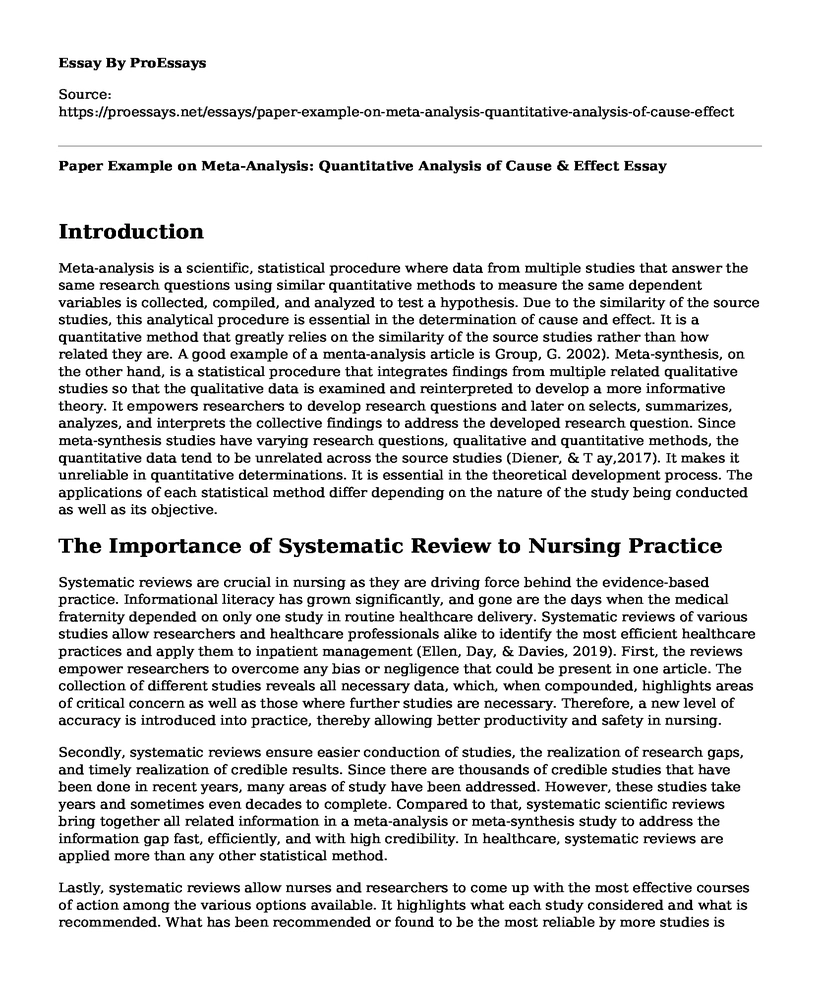Introduction
Meta-analysis is a scientific, statistical procedure where data from multiple studies that answer the same research questions using similar quantitative methods to measure the same dependent variables is collected, compiled, and analyzed to test a hypothesis. Due to the similarity of the source studies, this analytical procedure is essential in the determination of cause and effect. It is a quantitative method that greatly relies on the similarity of the source studies rather than how related they are. A good example of a menta-analysis article is Group, G. 2002). Meta-synthesis, on the other hand, is a statistical procedure that integrates findings from multiple related qualitative studies so that the qualitative data is examined and reinterpreted to develop a more informative theory. It empowers researchers to develop research questions and later on selects, summarizes, analyzes, and interprets the collective findings to address the developed research question. Since meta-synthesis studies have varying research questions, qualitative and quantitative methods, the quantitative data tend to be unrelated across the source studies (Diener, & T ay,2017). It makes it unreliable in quantitative determinations. It is essential in the theoretical development process. The applications of each statistical method differ depending on the nature of the study being conducted as well as its objective.
The Importance of Systematic Review to Nursing Practice
Systematic reviews are crucial in nursing as they are driving force behind the evidence-based practice. Informational literacy has grown significantly, and gone are the days when the medical fraternity depended on only one study in routine healthcare delivery. Systematic reviews of various studies allow researchers and healthcare professionals alike to identify the most efficient healthcare practices and apply them to inpatient management (Ellen, Day, & Davies, 2019). First, the reviews empower researchers to overcome any bias or negligence that could be present in one article. The collection of different studies reveals all necessary data, which, when compounded, highlights areas of critical concern as well as those where further studies are necessary. Therefore, a new level of accuracy is introduced into practice, thereby allowing better productivity and safety in nursing.
Secondly, systematic reviews ensure easier conduction of studies, the realization of research gaps, and timely realization of credible results. Since there are thousands of credible studies that have been done in recent years, many areas of study have been addressed. However, these studies take years and sometimes even decades to complete. Compared to that, systematic scientific reviews bring together all related information in a meta-analysis or meta-synthesis study to address the information gap fast, efficiently, and with high credibility. In healthcare, systematic reviews are applied more than any other statistical method.
Lastly, systematic reviews allow nurses and researchers to come up with the most effective courses of action among the various options available. It highlights what each study considered and what is recommended. What has been recommended or found to be the most reliable by more studies is more likely to be adopted (Ellen, Day, & Davies, 2019). As such, nurses are able to select the most productive evidence-based health practices; however, much unconventional they might look. As such, a scientific review is an indispensable tool in the era of evidence-based medicine.
Cosmic Question
Have you ever applied for a systematic review in any circumstance in the pursuit of your nursing career? Depending on the results you obtained, what would you do differently next time?
References
Diener, E., & Tay, L. (2017). A scientific review of the remarkable benefits of happiness for successful and healthy living. Happiness, 90.
Ellen, D., Day, S., & Davies, C. (2019). The Scientific Examination of Documents: Methods and Techniques: Methods and Techniques.
xGroup, G. M. A. T. G. (2002). Chemotherapy in adult high-grade glioma: a systematic review and meta-analysis of individual patient data from 12 randomised trials. The Lancet, 359(9311), 1011-1018. https://doi.org/10.1016/S0140-6736(02)08091-1
Cite this page
Paper Example on Meta-Analysis: Quantitative Analysis of Cause & Effect. (2023, May 03). Retrieved from https://proessays.net/essays/paper-example-on-meta-analysis-quantitative-analysis-of-cause-effect
If you are the original author of this essay and no longer wish to have it published on the ProEssays website, please click below to request its removal:
- Weight, Diet and Body Image Essay
- Quality Indicators: Nursing & Patient Care Impact - Essay Sample
- SWOT Technique
- Research Paper on Shoulder Complexity & Injury: Aching Pain & High Flexibility
- Accuracy in Dental Implantology: The Challenge of Precision - Essay Sample
- Essay Sample on Living By Values: Improving My Social & Working Life
- Ultrasound Applications Beyond Radiology: Critical Role in COVID-19 Diagnosis and Management







